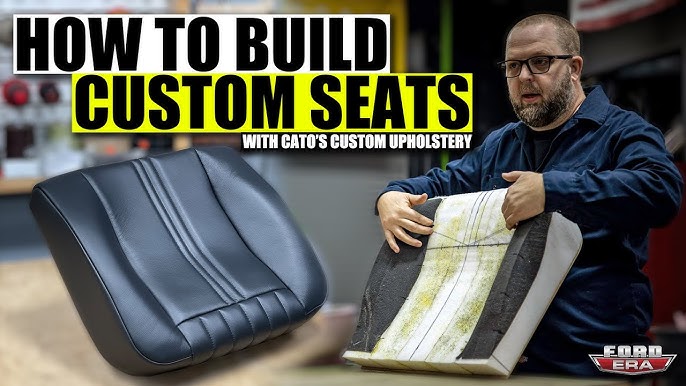To get started in automotive upholstery, learn the basics of sewing and familiarize yourself with upholstery tools. Acquire hands-on experience through practice and training.
Automotive upholstery is a specialized skill that enhances vehicle interiors. Start by learning essential sewing techniques and understanding different materials used in car interiors. Invest in quality tools like sewing machines, staple guns, and foam cutters. Join workshops or classes to gain practical experience and build confidence in your abilities.
Networking with professionals in the field can provide valuable insights and job opportunities. With dedication and practice, you can master the craft of automotive upholstery and offer services that transform car interiors, adding both value and comfort.

Introduction To Automotive Upholstery
Automotive upholstery involves the creation and repair of car interiors. This includes seats, dashboards, carpets, and door panels. It requires a mix of creativity and technical skills. This guide will help you get started in this fascinating field.
Why Choose Automotive Upholstery?
Automotive upholstery is a rewarding career. It offers a blend of artistry and craftsmanship. Here are some reasons to choose this profession:
- High Demand: Many classic and custom car owners need upholstery services.
- Creative Satisfaction: You get to design and create unique interiors.
- Job Flexibility: Work in a shop or start your own business.
- Hands-On Work: Perfect for those who enjoy working with their hands.
Skills You Need
To excel in automotive upholstery, you need specific skills. Here’s a list of essential skills:
| Skill | Description |
|---|---|
| Sewing | Ability to stitch fabrics and leather accurately. |
| Pattern Making | Create templates for various car parts. |
| Attention to Detail | Ensure every stitch and seam is perfect. |
| Material Knowledge | Understand different fabrics, leathers, and foams. |
| Tool Proficiency | Use specialized tools like sewing machines and staplers. |
Learning these skills can set you on the path to success. Practice makes perfect, so start with small projects. Build your confidence and move on to more complex tasks.
Essential Tools And Materials
Starting in automotive upholstery can be very rewarding. Using the right tools and materials is key. This guide will help you understand the basics. Let’s dive into the essential tools and materials you need.
Basic Tools
You need basic tools to start. These include a utility knife, scissors, and a tape measure. A good pair of scissors is crucial for cutting fabric. A utility knife helps with precise cuts. Use a tape measure to ensure accuracy.
- Utility Knife: For precise cuts.
- Scissors: For cutting fabric.
- Tape Measure: To ensure accuracy.
Specialized Equipment
Specialized equipment makes the job easier. A heavy-duty sewing machine is a must. It can handle thick materials. An air compressor helps with stapling. A heat gun is useful for stretching vinyl.
| Equipment | Purpose |
|---|---|
| Heavy-Duty Sewing Machine | Handles thick materials |
| Air Compressor | Helps with stapling |
| Heat Gun | Stretches vinyl |
Material Types
Choosing the right material is important. There are many types to consider. Leather is luxurious and durable. Vinyl is affordable and easy to clean. Fabric offers a wide range of designs.
- Leather: Luxurious and durable.
- Vinyl: Affordable and easy to clean.
- Fabric: Offers many designs.
Each material has its own benefits. Choose based on your needs and budget.
Learning The Basics
Starting in automotive upholstery can be exciting and rewarding. Learning the basics is the first step on this journey. This section will guide you through the foundational knowledge required to get started.
Safety First
Before diving into automotive upholstery, prioritize safety. Always wear protective gear such as gloves and safety glasses. Use a well-ventilated area to avoid inhaling fumes. Keep a first-aid kit nearby for minor injuries. Ensure your workspace is clean and organized to prevent accidents.
Understanding Upholstery Patterns
Understanding upholstery patterns is crucial. Patterns guide you in cutting and sewing fabric correctly. Start with simple designs and gradually move to complex ones. Here’s a quick overview of common patterns:
- Diamond – Classic and elegant, often used in luxury cars.
- Box – Simple and clean, ideal for a modern look.
- Channel – Vertical or horizontal lines, great for a sleek style.
Types Of Stitches
Knowing different stitches is essential. Each stitch serves a unique purpose. Here’s a list of common stitches used in automotive upholstery:
- Lock Stitch – Strong and durable, perfect for seats.
- Zigzag Stitch – Flexible and decorative, used for seams.
- Top Stitch – Adds a professional finish to edges.
Practice these stitches on scrap fabric before working on actual projects. This helps in mastering precision and consistency.
Getting Hands-on Experience
Getting hands-on experience is key in automotive upholstery. You need to practice to improve your skills. Starting with simple projects can build your confidence. Let’s explore some ways to get that experience.
Practice Projects
Start with small practice projects. These can be anything from reupholstering a dining chair to making cushion covers. Use these projects to learn basic stitching and fabric cutting skills.
- Reupholster a dining chair
- Make cushion covers
- Repair a torn car seat
You can also try using different materials like leather, vinyl, and fabric. This will help you understand how each material behaves.
Working On Car Seats
Once you feel confident with small projects, move on to car seats. Start with old or discarded seats. Practice removing the old upholstery and replacing it with new material.
- Remove old upholstery
- Measure and cut new material
- Attach the new material securely
Car seats are great for practicing stitching and fitting techniques. You will also learn how to handle different shapes and contours.
Fixing Common Issues
Learn to fix common issues in automotive upholstery. Some common problems include tears, loose seams, and worn-out padding. Practice fixing these issues to build your skill set.
| Issue | Solution |
|---|---|
| Tears | Use a patch or sew the tear |
| Loose seams | Re-stitch the seams |
| Worn-out padding | Replace the padding |
By fixing these common issues, you will become more confident. This practice prepares you for more complex projects.
Advanced Techniques
Advanced Techniques in automotive upholstery can elevate your skills to a professional level. Mastering these techniques allows you to offer custom, high-quality services. Here, we delve into three essential areas: Custom Designs, Installing Seat Heaters, and Working with Leather.
Custom Designs
Custom designs make your work unique and appealing. Start by understanding the client’s vision. Sketch the design on paper first. Use high-quality fabrics for better results.
- Discuss the design ideas with your client.
- Sketch a rough draft of the design.
- Choose the right fabrics and materials.
- Use a sewing machine for precise stitching.
Custom designs can include embroidery, color patterns, and unique stitches. Each element adds value to your upholstery work.
Installing Seat Heaters
Seat heaters offer comfort and luxury. Installing them requires some electrical knowledge. Here are the steps to follow:
- Purchase a quality seat heater kit.
- Remove the car seat from the vehicle.
- Detach the seat cover carefully.
- Place the heating elements as per the instructions.
- Connect the wires to the car’s power system.
- Test the seat heater before reassembling.
Ensure all connections are secure. This avoids any future electrical issues.
Working With Leather
Leather is a premium material for automotive upholstery. Working with leather requires precision and care. Follow these steps for best results:
| Steps | Description |
|---|---|
| 1 | Choose high-quality leather. |
| 2 | Cut the leather with sharp tools. |
| 3 | Use specialized needles and threads. |
| 4 | Stitch slowly for precision. |
| 5 | Apply leather conditioner after stitching. |
Leather adds a luxurious feel to the car interior. Ensure the stitches are tight and uniform.
Setting Up Your Workspace
Getting started in automotive upholstery can be exciting. The first step is setting up your workspace. This is where you will spend a lot of time, so it must be efficient and safe.
Choosing The Right Space
Selecting the right space is crucial for success. A garage or a dedicated room works best. Ensure the area is well-lit and ventilated. Good lighting helps you see details clearly. Proper ventilation keeps you safe from fumes and dust.
Consider the size of the space. You need room to move around your projects. A clutter-free environment boosts productivity. Keep the workspace clean and organized.
Organizing Your Tools
Organizing your tools is vital for efficient work. Use pegboards to hang frequently used tools. Install shelves for larger items. Keep small tools in labeled bins. This helps you find what you need quickly.
Here is a simple way to organize your tools:
- Hang tools on pegboards
- Use shelves for larger items
- Store small tools in labeled bins
Staying organized saves time and reduces stress. You can focus on your work without distractions.
Safety Precautions
Safety is a top priority in any workspace. Wear protective gear such as gloves and goggles. This protects you from harmful materials. Ensure you have a first aid kit nearby. Quick access to first aid can prevent serious injuries.
Follow these safety tips:
- Wear gloves and goggles
- Keep a first aid kit handy
- Use proper ventilation
Being careful keeps you healthy and allows you to work longer.
Building Your Portfolio
Creating a strong portfolio is essential in the automotive upholstery business. A well-crafted portfolio showcases your skills and attracts potential clients. It helps build trust and credibility.
Documenting Your Work
Documenting your work is crucial. Take clear photos of every project you complete. Make sure the lighting is good and the details are visible. Use different angles to capture the full scope of your work.
Keep a record of the materials and techniques used. This information can help future clients understand your expertise. It’s also useful for your own reference.
Consider making short videos of your process. Videos can show your skills in action. They can also make your portfolio more engaging.
Showcasing Before And After
Before and after photos are powerful tools. They show the transformation you can achieve. Clients love to see the difference your work makes.
| Before | After |
|---|---|
 |  |
Create a dedicated section in your portfolio for these photos. Label each set clearly to highlight the changes. This can help potential clients visualize the impact of your work.
Creating An Online Presence
An online presence is vital for any business today. Start by building a professional website. Use it to showcase your portfolio, services, and contact information.
Leverage social media platforms like Instagram and Facebook. Share your work regularly and engage with your audience. Use relevant hashtags to reach a wider audience.
Consider writing a blog to share tips and insights. This can help establish you as an expert in the field. It can also improve your website’s SEO.
Finally, ask satisfied clients for reviews and testimonials. Positive feedback can boost your credibility and attract more clients.

Starting Your Business
Beginning an automotive upholstery business can be exciting and profitable. This section outlines critical steps to get you started. Follow these steps to set your business up for success.
Legal Requirements
First, you need to meet legal requirements to operate your business. This involves several key steps:
- Register your business name.
- Obtain necessary licenses and permits.
- Get insurance to protect your business.
Check local laws to ensure compliance. This helps avoid legal issues later.
Pricing Your Services
Next, determine how to price your services. Consider these factors:
| Factor | Details |
|---|---|
| Material Costs | Include the cost of fabric and supplies. |
| Labor | Account for the time spent on each job. |
| Overhead | Include rent, utilities, and other expenses. |
Research competitors’ prices. This helps you set competitive rates.
Marketing Strategies
Finally, you need to market your business. Use these strategies:
- Create a website to showcase your work.
- Use social media to reach potential customers.
- Attend local car shows and events.
Offer discounts to first-time customers. This can help attract new clients.
Tips And Tricks
Getting started in automotive upholstery can be an exciting journey. With the right tips and tricks, you can streamline your work and avoid common pitfalls. Here are some key insights to help you excel in this trade.
Time-saving Techniques
- Organize Your Tools: Keep all your tools in one place. This saves time spent searching.
- Use Templates: Create templates for common patterns. This helps you work faster.
- Batch Work: Perform similar tasks together. Cut all materials before sewing.
- Invest in Quality Tools: Quality tools last longer and work better. They save you time and effort.
Common Mistakes To Avoid
- Skipping Measurements: Always measure twice. This ensures accuracy.
- Ignoring Material Types: Different materials need different treatments. Know your materials.
- Rushing the Process: Take your time. Rushing leads to mistakes.
- Overlooking Safety: Always wear safety gear. Protect yourself from harm.
Continuing Your Education
Staying updated in automotive upholstery is crucial. Here are ways to keep learning:
- Attend Workshops: Workshops offer hands-on experience. They teach new techniques.
- Read Industry Magazines: Magazines provide updates on trends. Stay informed about new materials and tools.
- Join Online Forums: Forums are great for advice. Connect with other professionals and share knowledge.
- Take Online Courses: Online courses offer flexibility. Learn at your own pace and expand your skills.
Resources For Beginners
Starting in automotive upholstery can seem overwhelming. Thankfully, many resources can help beginners. These resources include books, online tutorials, and community forums.
Recommended Books
Books are a great way to gain knowledge. Here are some highly recommended books for beginners:
- “Automotive Upholstery Handbook” by Don Taylor – This book covers basic to advanced techniques.
- “Custom Auto Interiors” by Ron Mangus – Learn about custom interiors with easy steps.
- “The Complete Upholsterer” by Carole Thomerson – Offers detailed instructions for various projects.
Online Tutorials
Online tutorials are perfect for visual learners. You can find many free and paid courses. Here are some popular platforms:
| Platform | Details |
|---|---|
| YouTube | Free videos on basic and advanced techniques. |
| Skillshare | Offers courses on specific skills with trial periods. |
| Udemy | Affordable courses with lifetime access. |
Community Forums
Joining forums can provide real-time help and advice. Here are some active communities:
- Auto Upholstery Forum – Discuss techniques and get tips from professionals.
- Reddit: r/AutoDetailing – Share your work and ask questions.
- Upholster.com Forum – Network with experienced upholsterers.
Frequently Asked Questions
What Tools Do I Need For Automotive Upholstery?
To start in automotive upholstery, you need basic tools like a sewing machine, staple gun, scissors, and upholstery needles.
How Much Does It Cost To Learn Automotive Upholstery?
Learning automotive upholstery can cost between $500 to $2000, depending on courses and materials.
Can I Learn Automotive Upholstery Online?
Yes, many online courses and tutorials are available to help you learn automotive upholstery skills.
How Long Does It Take To Master Automotive Upholstery?
Mastering automotive upholstery can take several months to a few years, depending on your dedication and practice.
Conclusion
Getting started in automotive upholstery is both rewarding and achievable. With dedication and practice, skills improve quickly. Remember to invest in quality tools and materials. Join online forums and communities for support and advice. Keep learning and stay updated with the latest trends.
Your journey in automotive upholstery can turn into a successful career.




